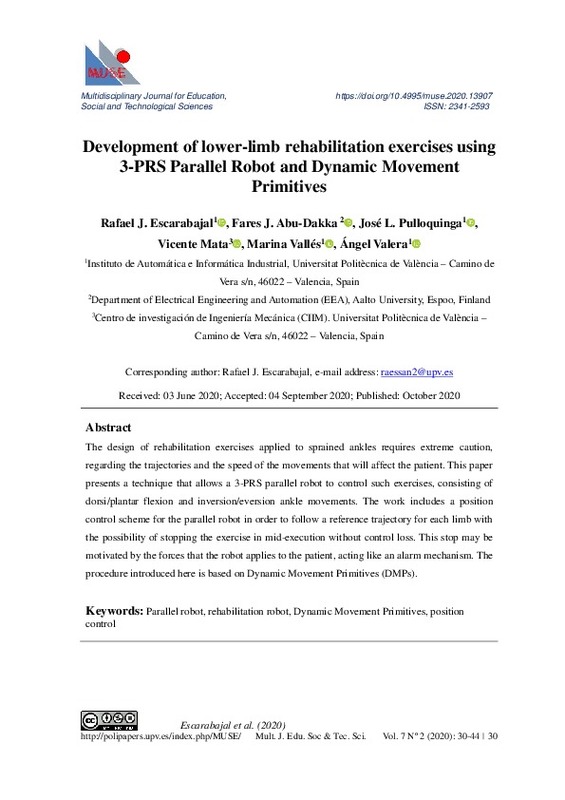Abu-Dakka, F. J., Valera, A., Escalera, J. A., Vallés, M., Mata, V., & Abderrahim, M. (2015). Trajectory adaptation and learning for ankle rehabilitation using a 3-PRS parallel robot. Lecture Notes in Computer Science (Including Subseries Lecture Notes in Artificial Intelligence and Lecture Notes in Bioinformatics), 9245, 483-494. https://doi.org/10.1007/978-3-319-22876-1_41
Atkeson, C. G., Moore, A. W., & Schaal, S. (1997). Locally Weighted Learning. Artificial Intelligence Review, 11(1-5), 11-73. https://doi.org/10.1007/978-94-017-2053-3_2
Brockett, C. L., & Chapman, G. J. (2016). Biomechanics of the ankle. Orthopaedics and Trauma, 30(3), 232-238. https://doi.org/10.1016/j.mporth.2016.04.015
[+]
Abu-Dakka, F. J., Valera, A., Escalera, J. A., Vallés, M., Mata, V., & Abderrahim, M. (2015). Trajectory adaptation and learning for ankle rehabilitation using a 3-PRS parallel robot. Lecture Notes in Computer Science (Including Subseries Lecture Notes in Artificial Intelligence and Lecture Notes in Bioinformatics), 9245, 483-494. https://doi.org/10.1007/978-3-319-22876-1_41
Atkeson, C. G., Moore, A. W., & Schaal, S. (1997). Locally Weighted Learning. Artificial Intelligence Review, 11(1-5), 11-73. https://doi.org/10.1007/978-94-017-2053-3_2
Brockett, C. L., & Chapman, G. J. (2016). Biomechanics of the ankle. Orthopaedics and Trauma, 30(3), 232-238. https://doi.org/10.1016/j.mporth.2016.04.015
Dai, J. S., Zhao, T., & Nester, C. (2004). Sprained Ankle Physiotherapy Based Mechanism Synthesis and Stiffness Analysis of a Robotic Rehabilitation Device. Autonomous Robots, 16(2), 207-218. https://doi.org/10.1023/B:AURO.0000016866.80026.d7
Díaz-Rodríguez, M., Mata, V., Valera, Á., & Page, Á. (2010). A methodology for dynamic parameters identification of 3-DOF parallel robots in terms of relevant parameters. Mechanism and Machine Theory, 45(9), 1337-1356. https://doi.org/10.1016/j.mechmachtheory.2010.04.007
Díaz, I., Gil, J. J., & Sánchez, E. (2011). Lower-Limb Robotic Rehabilitation: Literature Review and Challenges. Journal of Robotics, 2011(i), 1-11. https://doi.org/10.1155/2011/759764
Fanger, Y., Umlauft, J., & Hirche, S. (2016). Gaussian Processes for Dynamic Movement Primitives with application in knowledge-based cooperation. IEEE International Conference on Intelligent Robots and Systems, 2016-Novem, 3913-3919. https://doi.org/10.1109/IROS.2016.7759576
Gosselin, C., & Angeles, J. (1990). Singularity Analysis of Closed-Loop Kinematic Chains. IEEE Transactions on Robotics and Automation, 6(3), 281-290. https://doi.org/10.1109/70.56660
Hesse, S., & Uhlenbrock, D. (2000). A mechanized gait trainer for restoration of gait. Journal of Rehabilitation Research and Development, 37(6), 701-708.
Ijspeert, A. J., Nakanishi, J., Hoffmann, H., Pastor, P., & Schaal, S. (2013). Dynamical movement primitives: Learning attractor models formotor behaviors. Neural Computation, 25(2), 328-373. https://doi.org/10.1162/NECO_a_00393
Ijspeert, A. J., Nakanishi, J., & Schaal, S. (2002). Movement imitation with nonlinear dynamical systems in humanoid robots. Proceedings - IEEE International Conference on Robotics and Automation, 2, 1398-1403. https://doi.org/10.1109/ROBOT.2002.1014739
Liu, G., Gao, J., Yue, H., Zhang, X., & Lu, G. (2006). Design and kinematics simulation of parallel robots for ankle rehabilitation. 2006 IEEE International Conference on Mechatronics and Automation, ICMA 2006, 2006, 1109-1113. https://doi.org/10.1109/ICMA.2006.257780
Nakanishi, J., Morimoto, J., Endo, G., Cheng, G., Schaal, S., & Kawato, M. (2004). Learning from demonstration and adaptation of biped locomotion. Robotics and Autonomous Systems, 47(2-3), 79-91. https://doi.org/10.1016/j.robot.2004.03.003
Nemec, B., & Ude, A. (2012). Action sequencing using dynamic movement primitives. Robotica, 30(5), 837-846. https://doi.org/10.1017/S0263574711001056
Patel, Y. D., & George, P. M. (2012). Parallel Manipulators Applications-A Survey. Modern Mechanical Engineering, 02(03), 57-64. https://doi.org/10.4236/mme.2012.23008
Paul, R. P. (1981). Robot Manipulators: Mathematics, Programming, and Control : the Computer Control of Robot Manipulators (p. 279).
Reinkensmeyer, D. J., Aoyagi, D., Emken, J. L., Galvez, J. A., Ichinose, W., Kerdanyan, G., Maneekobkunwong, S., Minakata, K., Nessler, J. A., Weber, R., Roy, R. R., De Leon, R., Bobrow, J. E., Harkema, S. J., & Reggie Edgerton, V. (2006). Tools for understanding and optimizing robotic gait training. Journal of Rehabilitation Research and Development, 43(5), 657-670. https://doi.org/10.1682/JRRD.2005.04.0073
Safran, M. R., Benedetti, R. S., Bartolozzi, A. R., & Mandelbaum, B. R. (1999). Lateral ankle sprains: A comprehensive review part 1: Etiology, pathoanatomy, histopathogenesis, and diagnosis. In Medicine and Science in Sports and Exercise (Vol. 31, Issue 7 SUPPL., pp. S429-S437).
https://doi.org/10.1097/00005768-199907001-00004
Saglia, J. A., Tsagarakis, N. G., Dai, J. S., & Caldwell, D. G. (2013). Control strategies for patient-assisted training using the ankle rehabilitation robot (ARBOT). IEEE/ASME Transactions on Mechatronics, 18(6), 1799-1808. https://doi.org/10.1109/TMECH.2012.2214228
Schaal, S. (2006). Dynamic Movement Primitives -A Framework for Motor Control in Humans and Humanoid Robotics. In Adaptive Motion of Animals and Machines (pp. 261-280). https://doi.org/10.1007/4-431-31381-8_23
Sui, P., Yao, L., Lin, Z., Yan, H., & Dai, J. S. (2009). Analysis and synthesis of ankle motion and rehabilitation robots. 2009 IEEE International Conference on Robotics and Biomimetics, ROBIO 2009, 3, 2533-2538. https://doi.org/10.1109/ROBIO.2009.5420487
Tsoi, Y. H., Xie, S. Q., & Graham, A. E. (2009). Design, modeling and control of an ankle rehabilitation robot. Studies in Computational Intelligence, 177, 377-399. https://doi.org/10.1007/978-3-540-89933-4_18
Vallés, M., Díaz-Rodrguez, M., Valera, Á., Mata, V., & Page, Á. (2012). Mechatronic development and dynamic control of a 3-dof parallel manipulator. Mechanics Based Design of Structures and Machines, 40(4), 434-452. https://doi.org/10.1080/15397734.2012.687292
Xie, S. (2016). Advanced robotics for medical rehabilitation: current state of the art and recent advances. In Springer tracts in advanced robotics (Issue 108). https://doi.org/10.1007/978-3-319-19896-5
Yoon, J., Ryu, J., & Lim, K. B. (2006). Reconfigurable ankle rehabilitation robot for various exercises. Journal of Robotic Systems, 22(SUPPL.), 15-33. https://doi.org/10.1002/rob.20150
[-]









